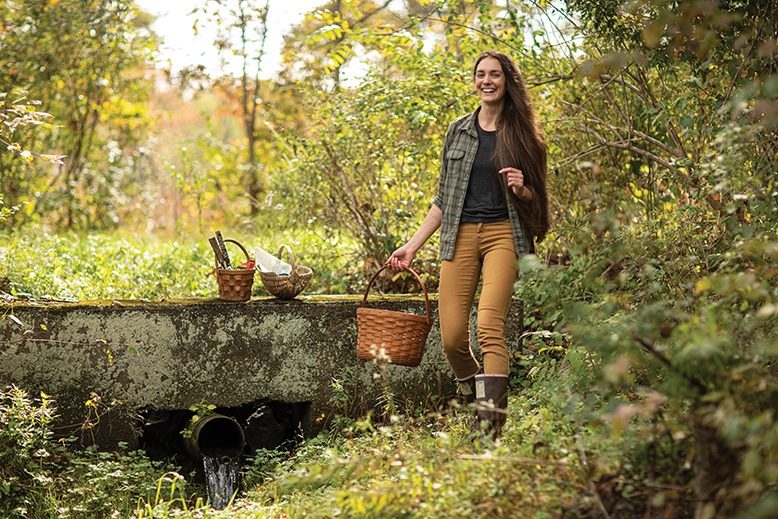
When Sarah Berman opens the hatch of her Subaru Outback, it looks like the backdrop for a Ralph Lauren ad. It’s filled with wicker baskets—some already brimming with hand-picked botanicals—and Wellies in sizes to fit the guests she sometimes brings along. Berman, a former model with hair that reaches past her lower back, is still a beauty at 33; but it is in nature, not on the catwalk, that she has found her true vocation. And it is in rural Sussex County, the northwest corner of the state, where she has put down roots as a professional forager.
She ventures into the woods surrounding the Crystal Springs Resort in Hamburg and emerges with ingredients to delight the chefs of its flagship, Restaurant Latour, a perennial on New Jersey Monthly’s annual Best Restaurants list.
Berman usually forages by herself on outings that can extend to 10 hours. But today, with a reporter and photographer in tow, she’s prepared an amuse-bouche of an adventure, a mini-excursion along the Papakating Creek in the shadow of the Kittatinny Ridge. Berman knows the path and its brambles well. Soon our boots will be wet from wading through the creek to a clump of trees practically strangled by wild concord grapes, and our baskets will be full of autumn olive berries, yarrow, turkey-tail mushrooms and bergamot leaves.

A handful of autumn olive berries. Photo by John Bessler
The takings on this brief expedition are, quite literally, low-hanging fruit for Berman, who maintains a spreadsheet of 350 local wild ingredients, categorized by peak availability, common and Latin names, flavor, and nutrition attributes.
Berman’s first memory of foraging dates back about 11 years, when she trekked with a friend to a little-known lake in New Jersey they knew was surrounded by wild blueberry bushes. “We walked around the edge of the lake barefoot,” she recalls. “We just gorged ourselves with wild blueberries.”
But Berman’s real education in finding food in the wild began two years later, when she moved to the historic Armstrong Farm, a six-acre homestead in Augusta. There, joined by her boyfriend and his brother, she settled down to practice sustenance farming. “I became obsessed with plants,” she says. “I started to see them, identify them. I started to buy books.”
During her eight years at the farm, Berman experimented with raising crops and became part of a small but growing community dedicated to sustainable agriculture. She developed relationships with veteran farmers who taught her the value of patient observation. She recalls one pointing out a tree and noting, “I’ve watched that tree grow my whole life.” Ultimately, Armstrong Farm began to produce crops that had value to local restaurants: garlic, garnishes, edible flowers and log-cultivated mushrooms. Meanwhile, Berman was reading voraciously and hiking through the woods with baskets. “Observation is the number one teacher,” she says. “And the internet is amazing.”
[RELATED: A Mushroom Farm Built in an Unlikely Vessel]
Early in her time at Armstrong Farm, Berman was recruited to forage for Latour’s executive chef at the time, Jean-Paul Lourdes, who accelerated her botanical education. “He was super intimidating. He had tattoos of eyeballs on his eyelids,” she recalls with a laugh. The chef was a devotee of the exacting Japanese style of tasting menu known as kaiseki. “He would ask questions like, ‘What was the temperature of the soil? Was the sun out? Were there clouds?’” Berman brought Lourdes 8 to 12 ingredients every Thursday, and Lourdes demanded the exact same haul on Saturdays: “He wanted them straight out of nature.”

Berman’s car with the proceeds of a morning hunt. Photo by John Bessler
Of course, not everything in nature is benign. Berman is especially wary of poison ivy, which she once got in her eye so badly that it swelled shut for days. Though she sometimes plays up-tempo music while foraging, she is careful to listen for bears, “particularly bears with cubs,” during berry season. On our small foraging trip by the Papakating, Berman pointed out one of the most toxic plants in nature, the poison water hemlock. “The root of one of these,” she warned, “is enough to kill a whole cow.”
But Berman, who grew up in central Florida and once had a close call with an alligator, is not one to dwell on danger. Nature is a balm to her, an almost magical source of treasures. On an outing this fall, she found a black-staining polypore, an edible mushroom nearly the size of a beach ball. She posted a picture on Instagram of herself holding it, almost like a bride with a bouquet.
Berman is a fan of the late Mary Oliver, whose poems about nature won her a Pulitzer Prize. Berman quotes by heart a key line from the poem When Death Comes: “When it’s over, I want to say: all my life/I was a bride married to amazement.” It has become something of a personal mantra. “The funny thing is,” Berman says, “I’m constantly having my breath taken away.”
